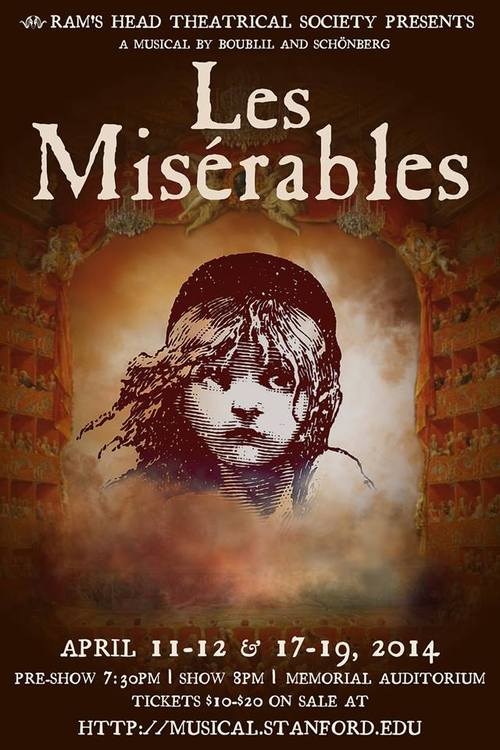
Les Misérables is the show every now-college-aged musical theater geek saw when they were ten years old, memorized, and has since been singing in the shower. When Ram’s Head asked the Stanford student body if “they hear the people sing” and opened auditions early last quarter, every closeted showgirl and -guy at Stanford felt at least some pull to come out of the woodwork (or that steaming shower stall) for a chance to sing legendary music and play legendary roles.
Based closely on the famed 1865 novel Les Misérables by French novelist Victor Hugo, the musical transports audiences into 19th-century France. It’s the story of Jean Valjean: a French peasant who, by breaking his parole after 19 years in prison, begins a quest to redeem himself and build a new life. Along the way, he encounters an array of characters, welcoming and otherwise, with the tide of violent revolution fast approaching.
Ram’s Head makes an ambitious move in producing Les Mis, because it’s an epic of giant proportions. It runs over two hours, is comprised of large-scale, tragic subject matter, and is almost entirely sung. Les Mis approaches opera territory and thus demands a daunting amount of vocal talent, acting chops, and outright endurance from cast and crew.
This weekend’s opening was a solid shot at this monster musical. Many new faces grace the stage, wielding some heavy-hitting talent under the bold direction of Sammi Cannold (’16), and many pieces of the production are done well.
A discussion of this production cannot begin, however, without comment on the exclusive pre-show Opera-Going Experience Project (OGEP). Intended to expand the audience’s experience of the well-known musical, OGEP reimagines a courtyard adjacent to MemAud as an arcade of the Salle le Pelletier, home of the Paris Opéra, in 1862. During a half-hour pre-show “experience,” actors wander the “arcade” in full costume playing 19th-century French opera-goers, and audience members walk by them.
For audience members, it takes only a few moments of eavesdropping to realize these actors are famous historical well-to-dos – the likes of Monet, Manet, Wagner, even Victor Hugo himself (not to mention his wife and mistress). Thus, OGEP demonstrates what French social elite would have been doing and saying in 1862, the year Victor Hugo’s published Les Misérables. Audience members are meant to discover, among other things, that the novel’s anti-bourgeois content roused some political stir. This, of course, is a worthy preface for the evening’s show, Les Misérables, which audience members are about to watch.
Although OGEP serves as an interesting appetizer, the musical itself is the true center of attention here, and it is worthy of stand-alone praise. Arguably the most remarkable characteristic of this production is the amount of vocal talent in the cast, particularly in leading roles. And that’s a tall order. Valjean’s songs, for example, are trying for any singer, mind-boggling in their range requirements and marathon-esque in their length.
Matt Billman (’15) gives a prodigious vocal performance as Valjean. His singing is exactly what Valjean’s needs to be: of superstar quality. From the first scene onward, Billman’s voice resonates with the clarity and confidence of a Broadway regular twice his age. Particularly impressive is the song, “Bring Him Home,” in which his voice starts as nearly a whisper, swelling and crescendoing into a bellowing belt, then back again. Billman’s voice sends a pang of vibrations through a listener’s body, as a mallet does to a tuning fork.
Other leading roles follow Billman’s suit. Ram’s Head newcomer Praveen Ramesh nails Javert’s part, with deep warbling and militant staccatos necessary for the role. David López (’17) sings the tenor part of Marius with nuance and style; and Amy DuBose (’15), a standout, is a spellbinding Eponine, her sound alternating between gorgeous, bell-like clarity and powerhouse belts that can move audiences to tears.
One area in which the show lacks, however, is character development in acting. Billman captures the attention of audience members with his golden voice, but he sometimes lacks the appropriate physicality to embody Valjean. He often navigates the stage with the gait of a college kid instead of the upright, confident prisoner-turned-good-guy he should be. He is not alone. Other leading roles also seem to lack character work, sometimes resorting to shallow, one-dimensional versions of their characters instead of developing complex, nuanced, on-stage humans. Brady Richter (’15) as the conniving innkeeper Thénardier, and Jessia Hoffman (’15) as his debaucherous wife, are clearly the character actors who offer hilarious comedic relief. Yet it is clear that this production places a higher value on vocals than acting (and perhaps rightly so, given the show’s challenging music).

By the second act, however, the actors become more compelling . When Eponine dies in the arms of Marius, their heartfelt connection on stage yielded audible sniffling throughout the audience. And in the final scene, when characters emerge from the wings and aisles to surround the audience, goose-bumps arise on arms and shivers slide down spines. When moments of creative direction and deliberate acting surface, it’s the stuff of greatness, but it takes a while to get there.
Les Misérables is, no doubt, a daunting project. But Ram’s Head is ultimately successful in taming the beast. It gives audiences what they want from a theatrical experience – through the power of its music and its story, the audience feels palpable moments of laughter, hope, tragedy, and prevailing kindness through love. Despite a few moments that expose exhaustion or areas for improvement, it has frequent sparks of theatrical magic and inspires an awe felt even after the show’s end, and that makes any show worth seeing.

Les Misérables is playing at Memorial Auditorium on April 11-12 and 17-19. You can buy tickets at musical.stanford.edu.
